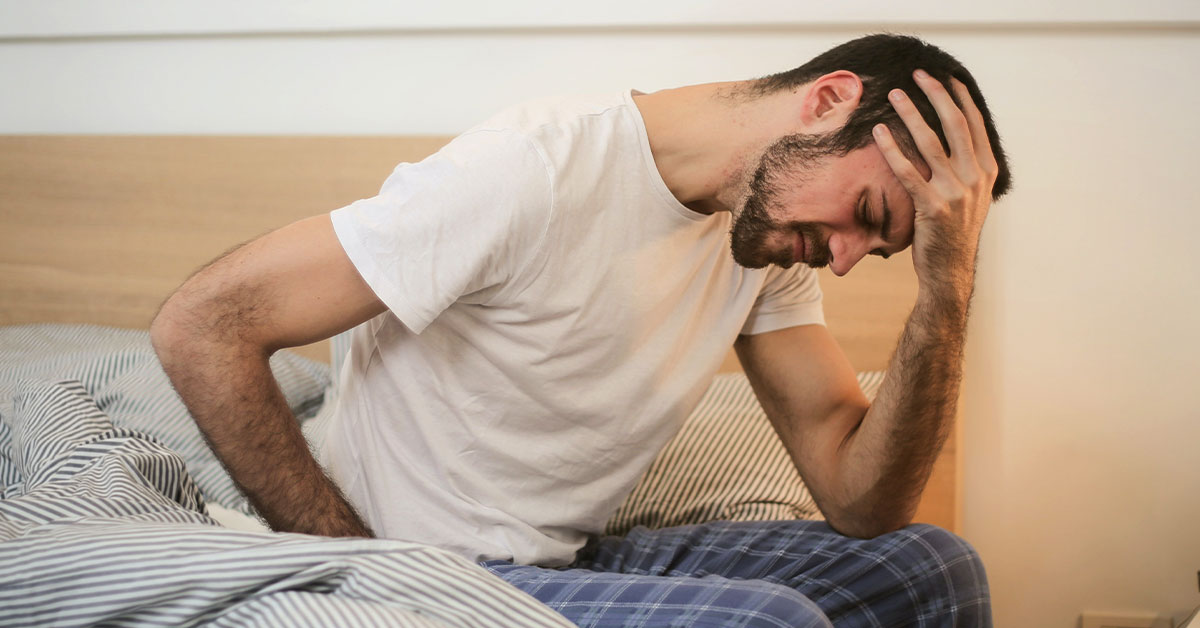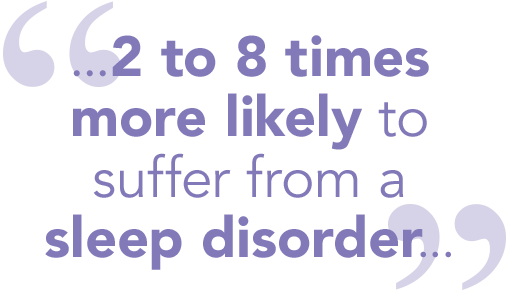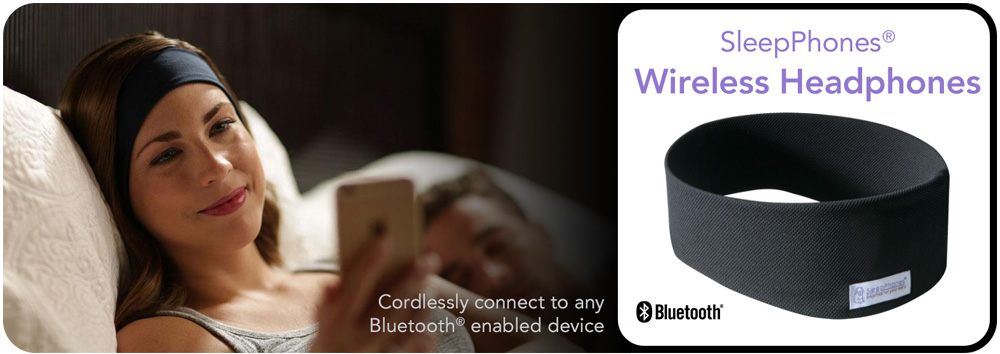
The Connection Between Sleep and Migraine Headaches
While there is still a lot we don't know about migraine headaches, research shows a clear connection between their frequency and severity and the quality and quantity of sleep one gets. If you're one of the 39 million Americans who suffer from migraines or know someone who is, you probably know that rest is essential for relieving symptoms.

Unfortunately, those with sleep disorders are more susceptible to migraines and vice versa. According to the American Migraine Foundation, those who experience these debilitating headaches are two to eight times more likely to suffer from a sleep disorder such as sleep apnea, insomnia, or teeth grinding.
The first step to help you or a loved one get better sleep and minimize the effects of migraine headaches is to understand the relationship between the two. Read on to learn more about how they’re connected, how to potentially reduce the impact of certain sleep disorders, and how many people are blocking out unnecessary light and sounds while they’re sleeping.
Migraines and Sleep Disorders
Getting too much or too little sleep, as well as changes to sleep schedules, can trigger a migraine. For that reason, jet lag and sudden changes in work shift can also contribute to migraine episodes. Interestingly, half of all migraine attacks occur between 4 and 9 a.m., a window of time when many people are still asleep or on the verge of waking up.
These Sleep Disorders Are Most Closely Linked to Migraines
Insomnia
Insomnia is a sleep disorder associated with difficulty falling and staying asleep. People who have insomnia are often chronically fatigued, have trouble concentrating, suffer from mood disturbances.
If you believe you suffer from insomnia, please visit these resources:
- Natural Remedies for Insomnia
- Sleep Hygiene Rules for Insomnia Prevention
- How to Handle Postpartum Insomnia
- Medications That Can Cause Insomnia
- The Link Between Depression and Insomnia
- Free Insomnia Solution for the Insomniac
Sleep Apnea
Sleep apnea is a common sleep disorder where the afflicted has one or more pauses in breathing while asleep. The pauses may last anywhere from a few seconds to minutes and can occur as many as 30 times or more an hour.
If you believe you suffer from sleep apnea, please visit these resources:
- Sleep Apnea Raises the Risk of Heart Disease: How to Improve Your Outcome
- Top 8 Reasons to Treat Sleep Apnea [Infographic]
- Obstructive Sleep Apnea
Shift Work Disorder
Shift work sleep disorder (SWSD) is a serious condition that can affect both your physical and mental health, as well as negatively impact your performance and safety on the job. SWSD occurs during work scheduling adjustment periods, such as a transition from first to third shift; that is, working an eight-hour period during the day and then pivoting to be present to your job during the night and rotating back and forth regularly.
If you believe you suffer from SWSD, please visit these resources:
Teeth Grinding
Nocturnal teeth grinding, also known as sleep bruxism, is a sleep-related movement disorder that involves clenching or grinding teeth during sleep. People who grind their teeth at night often have comorbid conditions such as snoring and sleep apnea.
Snoring
Snoring is loud breathing during sleep. It occurs when our bodies relax during sleep, and our airways narrow slightly, causing breathing vibrations across the tongue, soft palate, uvula, and other tissue. While it’s not clear why some people snore, and some don’t, snoring is associated with poor sleeping posture and weight gain.
If you snore, or if your partner does, please visit these resources:
- My partner goes to bed before me and snores!
- Dealing With a Significant Other Who Snores
- SleepPhones Snoring Solutions
How to Sleep Better with Migraines
In a recent study, researchers found that high frequency of migraines directly correlates with poor sleep quality and are more prevalent in poor sleepers. If your sleep seems to be affecting your migraines, try to:
Assess Your Pillows and Positions
If you consistently wake up with a headache or neck pain, try changing your pillow to a different firmness. Everyone will have a different preference when it comes to comfort, but for those suffering from migraines and poor sleep, you also want to consider what works best to alleviate the symptoms of your condition(s). If snoring is a problem, make an effort to sleep more on your side instead of your back.
Maintain a Healthy Weight
Excess weight can affect your ability to breathe at night with additional fat deposits around the neck muscles. Certain foods, such as nuts, complex carbs, cottage cheese, and some fruits, contribute to a restful night’s sleep and a healthy weight, so reexamining your diet and consumption habits is a great, easy place to start.
Establish a Sleep/Wake Routine
Your daily routine should include a wind-down period. You should attempt to go to bed at the same time each night and try to wake up around the same time each day—even on the weekends. Do something relaxing, such as writing your thoughts down in a journal, drinking a cup of decaffeinated tea, or reading a book.
It’s important to sleep during the right phase of your circadian cycle. Lastly, understand how much sleep you need. While eight hours of sleep may work for most people, it doesn't mean it’s right for you; sometimes, less is more or more is more—it all depends on you and what your body needs.
Spend Time in Natural Light
Sunlight helps regulate your circadian rhythm. Try to spend at least some portion of your day outdoors during the daytime.
Create a Peaceful Sleeping Environment
Use blackout curtains or a sleep mask to block light and mute notifications from your phone. You can also block out irritating noises with headphones that are designed for sleeping. Use your bedroom only for sleep and sex.
Limit Caffeine Intake
While caffeine can help stave off or mitigate a migraine, it is essential to pay attention to the timing of your consumption. Consuming caffeine 3 to 6 hours before bed can negatively impact sleep quality. Regulating and reducing caffeine consumption is essential for migraine management.
Eliminate Drugs, Minimize Alcohol
Both drugs and alcohol can negatively impact the quality and quantity of your sleep. Furthermore, the hangover effects of each can significantly increase the likelihood of a migraine onset. The same goes for using tobacco/nicotine products.
Exercise 30 Minutes a Day
To minimize migraines frequency, try working out each morning or early afternoon for 30 minutes. It can be as simple as a walk. However, by and large, you don’t want to exercise at night as it can actually wake you up.
Minimize Screen Time
It’s easy to veg in front of the TV or scroll through your newsfeeds after a long day. But the light from your electronics significantly impacts your ability to fall asleep. This effect is caused by the blue light that devices emit.
Many devices now feature ‘night mode’ or similar functions that reduce a screen’s brightness. While these are useful features to engage as day gives way to evening, you still want to unplug before your head hits the pillow to give your body the time it needs to ready itself for sleep.
Watch Your Diet—and Your Watch
It’s not only important to watch what you eat, but also when you eat. Eat dinner at least three hours before you get in bed. Further, eliminate any drinks other than water two hours before bed.
SleepPhones® Headphones Can Help
If you’re in need of a better night’s sleep to help you minimize the impact of your migraines, consider trying SleepPhones®. SleepPhones® can help you create a more slumber-friendly environment by eliminating light, minimizing distracting noises, and playing calming sleep sounds. Visit our SleepPhones® product page to view our corded and wireless headphones starting at $39.95.
Customers Using SleepPhones® Headphones For Migraines and Headaches
- "For the record. I am a HUGE fan. I have sold many of your products to friends! I am a chronic migraine sufferer and sleep is imperative so I wear my SleepPhones® absolutely every night. It is a lifesaver." - Alicia H.
- "As soon as the schools closed and we were sheltering at home my son started showing signs of anxiety- stomach aches, headaches, restlessness. I bought a pair of SleepPhones® and have him listening to a hypnosis for deep sleep & and anxiety relief at bedtime and what a difference! It’s been a game changer." - lifewithpumpkin
- "I use them to block out snoring from my partner and my dog. I also get migraines and need to sleep in the day and they block everything else out too. And no, I don't listen to music. I put together a mix of white noise and rain by using the app Relax Melodies. You choose whatever you want to mix and change the volume of each sound separately on the app." - EnRevanche

